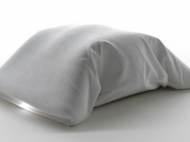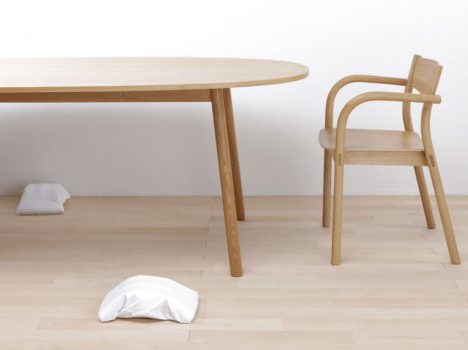Panasonic Fukitorimushi scrubs the floor while you sleep
 Fukitorimushi is an autonomous floor-cleaning robot that crawls like an inchworm and uses a super-absorbent nanofiber cloth to wipe up microscopic dust and residue that ordinary vacuums leave behind. Unveiled at the recent Tokyo Fiber Senseware (page in Japanese language) exposition in Milan, Fukitorimushi (scrubbing bug) is designed by Panasonic and incorporates nanofiber technology developed by textile maker Teijin, Ltd.
Fukitorimushi is an autonomous floor-cleaning robot that crawls like an inchworm and uses a super-absorbent nanofiber cloth to wipe up microscopic dust and residue that ordinary vacuums leave behind. Unveiled at the recent Tokyo Fiber Senseware (page in Japanese language) exposition in Milan, Fukitorimushi (scrubbing bug) is designed by Panasonic and incorporates nanofiber technology developed by textile maker Teijin, Ltd.
Although many described it as a competitor to popular cleaning robots like Roomba or Scooba from iRobot, it actually isn’t belonging to the same niche as the rest of the popular cleaning robots.
The robot cleans by dragging its nanocloth belly across the floor. It crawls around slowly in search for dirt and is rather silent (comparing to its “competition”). Fukitorimushi, moves around by flexing and stretching its body like an inchworm. It uses “feelers” of blue-white light to search for dirty spots. When it finds dirt, the robot emits a red light and devotes extra effort to cleaning that area. After it finishes the cleaning, the machine returns to its charging station to recharge its battery.
Fukitorimushi’s body is covered in Teijin’s Nanofront cloth, which is made of polyester filament fibers measuring 700 nanometers in diameter (about 7,500 times thinner than the average human hair). The nanofibers significantly increase the fabric’s surface area and porosity, giving it superior wiping characteristics and the ability to absorb oil and ultra-fine dust particles less than one micron in diameter. The large surface contact area also increases the fabric’s friction with the floor and makes it resistant to sliding. The robot relies on this increased friction to push itself forward while wiping the floor.
The way the machine creeps across the floor may seem a little strange at first, but the designers say people tend to grow fond of the robotic creature after watching it for a while. The owner must periodically replace Fukitorimushi’s nanocloth cover with a clean one. The designers suggest this task of looking after the Fukitorimushi may encourage a pet-like affection for the machine.
The robot doesn’t vacuum or use water in order to clean the floor so it’s more silent, on the other hand it is very slow and has a constant need for replacement of its cover. The conclusion is that if you are in need for a spotless home it should be used along other cleaners in order to make some of our living areas super-clean while you sleep. Unless they make some major changes, that will be the only usage of Fukitorimushi.










Leave your response!